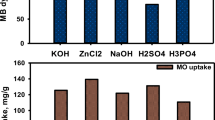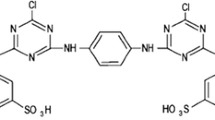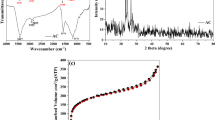Abstract
Water contamination by Congo red dye (CRD), used in textile industries to impart colour to the fabric, is a ubiquitous environmental issue. Amid substantial advances in the treatment approaches for textile discharges, capacitive deionization (CDI) is the new horizon to the field with energy-efficient statistics. For the first time, this investigation involves removing CRD using CDI via fabricated electrodes using the waste walnut shell (WNS)-derived activated carbon coated over graphite sheets revealing microporous morphologies. The study involves the examination of the varying initial CRD concentration (10–200 mg/L) and electro-sorption time (30–240 min) for capacitive removal on the application of small potential 1.2 V. Moreover, the Langmuir model of isotherm and the second-order kinetics were best fitted to the equilibrium data with R2 of 0.99. The maximum sorption capacity was 140.84 mg/g at a sorption time of 120 min and an inlet concentration of 200 mg/L CRD with potential application of 1.2 V. The process kinetics suggested monolayer formations and the existence of proportionality between dye molecules adsorbed over the electrode’s surface. The mechanism of adsorption has been examined here for capacitive dye removal proposing the deionization of dye molecules due to potential applications around both terminals. To the best of the author’s knowledge, the electrostatic force was the prominent reason behind the sorption of dye molecules. In addition to this, the energy aspects of the process were evaluated, revealing 0.21 kWh of specific energy consumption. Henceforth, the investigation suggests that CDI can be a plausible cost-effective system for treating textile effluents.
Graphical abstract








Similar content being viewed by others
References
Agarwal M, Singh K (2017) Removal of copper, cadmium, and chromium from wastewater by modified wheat bran using Box—Behnken design : kinetics and isotherm. Sep Sci Technol 00:1–14. https://doi.org/10.1080/01496395.2017.1417316
Agarwal M, Kumari P, Dubey S, Gupta R, Dohare RK (2019) Adsorption behavior of Azo dyes on carbon nanotubes grown on alumina : process optimization kinetics, and equilibrium study. J Environ Eng 145:1–16. https://doi.org/10.1061/(ASCE)EE.1943-7870.0001482
Anantha MS, Olivera S, Hu C, Jayanna BK (2020) Environmental technology & innovation comparison of the photocatalytic, adsorption and electrochemical methods for the removal of cationic dyes from aqueous solutions. Environ Technol Innov 17:100612. https://doi.org/10.1016/j.eti.2020.100612
Baghel R, Upadhyaya S, Chaurasia SP, Singh K, Kalla S (2018) Optimization of process variables by the application of response surface methodology for naphthol blue black dye removal in vacuum membrane distillation. J Clean Prod 199:900–915. https://doi.org/10.1016/j.jclepro.2018.07.214
Caprarescu S, Miron AR, Purcar V, Radu AL, Sarbu A, Ianchis R, Ebrasu DI (2017) Commercial gooseberry buds extract containing membrane for removal of methylene blue dye from synthetic wastewaters. Rev Chim 68:1757–1762. https://doi.org/10.37358/rc.17.8.5759
Dujearic-stephane K, Panta P, Shulga YM, Kumar A (2020) Bioresource technology reports physico-chemical characterization of activated carbon synthesized from Datura metel ’ s peels and comparative capacitive performance analysis in acidic electrolytes and ionic liquids. Bioresour Technol Reports 11:100516. https://doi.org/10.1016/j.biteb.2020.100516
Gaikwad MS, Balomajumder C (2018) Removal of Cr(VI) and fluoride by membrane capacitive deionization with nanoporous and microporous Limonia acidissima (wood apple) shell activated carbon electrode. Sep Purif Technol 195:305–313. https://doi.org/10.1016/j.seppur.2017.12.006
Gan L, Wu Y, Song H, Zhang S, Lu C, Yang S, Wang Z, Jiang B, Wang C, Li A (2019) Separation and puri fi cation technology selective removal of nitrate ion using a novel activated carbon composite carbon electrode in capacitive deionization. Sep Purif Technol 212:728–736
Ghosh RK, Ray DP, Debnath S, Tewari A, Das I (2019) Optimization of process parameters for methylene blue removal by jute stick using response surface methodology. Environ Prog Sustain Energy. https://doi.org/10.1002/ep.13146
Gupta K, Khatri OP (2019) Fast and efficient adsorptive removal of organic dyes and active pharmaceutical ingredient by microporous carbon: effect of molecular size and charge. Chem Eng J 378:122218. https://doi.org/10.1016/j.cej.2019.122218
Hashim KS, Al-Saati NH, Alquzweeni SS, Zubaidi SL, Kot P, Kraidi L, Hussein AH, Alkhaddar R, Shaw A, Alwash R (2019) Decolourization of dye solutions by electrocoagulation: an investigation of the effect of operational parameters. IOP Conf Ser Mater Sci Eng. https://doi.org/10.1088/1757-899X/584/1/012024
Jawad AH, Bardhan M, Islam MA, Islam MA, Syed-Hassan SSA, Surip SN, ALOthman ZA, Khan MR (2020) Insights into the modeling, characterization and adsorption performance of mesoporous activated carbon from corn cob residue via microwave-assisted H3PO4 activation. Surf Interfaces 21:100688. https://doi.org/10.1016/j.surfin.2020.100688
Khalilzadeh Shirazi E, Metzger JW, Fischer K, Hassani AH (2020) Design and cost analysis of batch adsorber systems for removal of dyes from contaminated groundwater using natural low-cost adsorbents. Int J Ind Chem 11:101–110. https://doi.org/10.1007/s40090-020-00205-1
Kyaw HH, Al-Mashaikhi SM, Myint MTZ, Al-Harthi S, El-Shafey ESI, Al-Abri M (2021) Activated carbon derived from the date palm leaflets as multifunctional electrodes in capacitive deionization system. Chem Eng Process Process Intensif 161:108311. https://doi.org/10.1016/j.cep.2021.108311
Li D, Ning XA, Yuan Y, Hong Y, Zhang J (2020) Ion-exchange polymers modified bacterial cellulose electrodes for the selective removal of nitrite ions from tail water of dyeing wastewater. J Environ Sci (china) 91:62–72. https://doi.org/10.1016/j.jes.2020.01.002
Liu Q, Li X, Wu Y, Qing M, Tan G, Xiao D (2019) Pine pollen derived porous carbon with efficient capacitive deionization performance. Electrochim Acta 298:360–371. https://doi.org/10.1016/j.electacta.2018.12.072
Liu G, Qiu L, Deng H, Wang J, Yao L, Deng L (2020) Ultrahigh surface area carbon nanosheets derived from lotus leaf with super capacities for capacitive deionization and dye adsorption. Appl Surf Sci 524:146485. https://doi.org/10.1016/j.apsusc.2020.146485
Liu X, Liu L, Zhang J, Meng Q (2021) Colloids and surfaces A: physicochemical and engineering aspects capacitive deionization and methyl orange removal of holey graphene hydrogels. Colloids Surf A Physicochem Eng Asp 618:126463. https://doi.org/10.1016/j.colsurfa.2021.126463
Lu T, Liu Y, Xu X, Pan L, Alothman AA, Shapter J, Wang Y, Yamauchi Y (2021) Highly efficient water desalination by capacitive deionization on biomass-derived porous carbon nanoflakes. Sep Purif Technol 256:117771. https://doi.org/10.1016/j.seppur.2020.117771
Maheshwari K, Agrawal M (2020) Journal of environmental chemical engineering advances in capacitive deionization as an effective technique for reverse osmosis reject stream treatment. J Environ Chem Eng 8:104413. https://doi.org/10.1016/j.jece.2020.104413
Maheshwari K, Agarwal M, Solanki YS (2020a) Materials today : Proceedings Electrode material effect on electrochemical characterization , properties and operational parameters in capacitive deionization. Mater Today Proc. https://doi.org/10.1016/j.matpr.2020.08.750
Maheshwari K, Solanki YS, Ridoy MSH, Agarwal M, Dohare R, Gupta R (2020b) Ultrasonic treatment of textile dye effluent utilizing microwave-assisted activated carbon. Environ Prog Sustain Energy. https://doi.org/10.1002/ep.13410
Maheshwari K, Agrawal M, Gupta AB (2021a) Experimental Investigation for treating the RO reject stream through capacitive deionization. Sep Purif Technol. https://doi.org/10.1016/j.seppur.2021.119261
Maheshwari K, Agrawal M, Gupta AB (2021b) Experimental investigation for treating the RO reject stream through capacitive deionization. Sep Purif Technol 276:119261. https://doi.org/10.1016/j.seppur.2021.119261
Maniscalco MP, Corrado C, Volpe R, Messineo A (2020) Bioresource technology reports evaluation of the optimal activation parameters for almond shell bio-char production for capacitive deionization. Bioresour Technol Reports 11:100435. https://doi.org/10.1016/j.biteb.2020.100435
Moneer AA, El-mallah NM, El-sadaawy MM, Khedawy M, Ramadan MSH (2021) Kinetics, thermodynamics, isotherm modeling for removal of reactive Red 35 and disperse yellow 56 dyes using batch bi-polar aluminum electrocoagulation. Alex Eng J 60:4139–4154. https://doi.org/10.1016/j.aej.2021.02.061
Nasseh N, Arghavan FS, Rodriguez-Couto S, Hossein Panahi A (2020) Synthesis of FeNi3/SiO2/CuS magnetic nano-composite as a novel adsorbent for Congo Red dye removal. Int J Environ Anal Chem. https://doi.org/10.1080/03067319.2020.1754810
Patel SR, Parikh SP (2021) Chromium removal from industrial effluent by electrocoagulation: operating cost and kinetics study. J Environ Treat Techn 9:621–628
Quan G, Wang H, Zhu F, Yan J (2018) Porous biomass carbon coated with SiO2 as High performance electrodes for capacitive deionization. BioResources 13:437–449. https://doi.org/10.15376/biores.13.1.437-449
Rambabu K, Bharath G, Hai A, Luo S, Liao K, Haija MA, Banat F, Naushad M (2020) Development of watermelon rind derived activated carbon/manganese ferrite nanocomposite for cleaner desalination by capacitive deionization. J Cleaner Prod 272:122626. https://doi.org/10.1016/j.jclepro.2020.122626
Renu, Agarwal M, Singh K (2018) Removal of copper, cadmium, and chromium from wastewater by modified wheat bran using Box-Behnken design: kinetics and isotherm. Sep Sci Technol 53:1476–1489. https://doi.org/10.1080/01496395.2017.1417316
Saad MS, Balasubramaniam L, Wirzal MDH, Halim NSA, Bilad MR, Nordin NAHM, Putra ZA, Ramli FN (2020) Integrated membrane–electrocoagulation system for removal of celestine blue dyes in wastewater. Membranes (basel) 10:1–12. https://doi.org/10.3390/membranes10080184
Senoussi H, Bouhidel KE (2018) Feasibility and optimisation of a batch mode capacitive deionization (BM CDI) process for textile cationic dyes (TCD) removal and recovery from industrial wastewaters. J Cleaner Prod 205:721–727
Singh NB, Nagpal G, Agrawal S (2018) Environmental technology & innovation water purification by using adsorbents : a review. Environ Technol Innov 11:187–240. https://doi.org/10.1016/j.eti.2018.05.006
Singh Y, Agarwal M, Gupta S, Shukla P (2019) Journal of Environmental Chemical Engineering Application of synthesized Fe/Al/Ca based adsorbent for de fl uoridation of drinking Water and its signi fi cant parameters optimization using response surface methodology. J Environ Chem Eng 7:103465. https://doi.org/10.1016/j.jece.2019.103465
Singh Solanki Y, Agarwal M, Gupta S, Shukla P, Maheshwari K, Midda MO (2019) Application of synthesized Fe/Al/Ca based adsorbent for defluoridation of drinking Water and its significant parameters optimization using response surface methodology. J Environ Chem Eng 7:103465. https://doi.org/10.1016/j.jece.2019.103465
Sufiani O, Tanaka H, Teshima K, Machunda RL, Jande YAC (2020) Enhanced electrosorption capacity of activated carbon electrodes for deionized water production through capacitive deionization. Sep Purif Technol. https://doi.org/10.1016/j.seppur.2020.116998
Suhaimi A, Mahmoudi E, Siow KS, Mohammad AW, Mohd Razip Wee MF (2021) Nitrogen incorporation by plasma polymerization of heptylamine on PES membrane for removal of anionic dye (Congo red). Int J Environ Sci Technol 18:1443–1452. https://doi.org/10.1007/s13762-020-02879-7
Thamilselvan A, Govindan K, Nesaraj AS, Maheswari SU, Oren Y, Noel M, James EJ (2018) Investigation on the effect of organic dye molecules on capacitive deionization of sodium sulfate salt solution using activated carbon cloth electrodes. Electrochim Acta 279:24–33. https://doi.org/10.1016/j.electacta.2018.05.053
Wang Y, Du B, Wang J, Wang Y, Gu H, Zhang X (2018) Synthesis and characterization of a high capacity ionic modified hydrogel adsorbent and its application in the removal of Cr(VI) from aqueous solution. J Environ Chem Eng 6:6881–6890. https://doi.org/10.1016/j.jece.2018.10.048
Xie Z, Shang X, Yan J, Hussain T, Nie P, Liu J (2018) Biomass-derived porous carbon anode for high-performance capacitive deionization. Electrochim Acta 290:666–675. https://doi.org/10.1016/j.electacta.2018.09.104
Xu J, Xu D, Zhu B, Cheng B, Jiang C (2018) Applied Surface Science Adsorptive removal of an anionic dye Congo red by flower-like hierarchical magnesium oxide ( MgO ) -graphene oxide composite microspheres. Appl Surf Sci 435:1136–1142. https://doi.org/10.1016/j.apsusc.2017.11.232
Yaseen DA, Scholz M (2019) Textile dye wastewater characteristics and constituents of synthetic effluents: a critical review. International Journal of Environmental Science and Technology. Springer Berlin Heidelberg. https://doi.org/10.1007/s13762-018-2130-z
Acknowledgements
Authors would like to thank MRC, MNIT Jaipur for the characterization done in the present article. Also, the authors like to thanks MNIT Jaipur for providing the laboratory facilities to research and explore new approaches in the field.
Author information
Authors and Affiliations
Corresponding author
Additional information
Publisher's Note
Springer Nature remains neutral with regard to jurisdictional claims in published maps and institutional affiliations.
Rights and permissions
About this article
Cite this article
Maheshwari, K., Agarwal, M. & Gupta, A.B. Experimental investigation of Congo red dye treatment via capacitive deionization utilizing agro-waste. Chem. Pap. 76, 3119–3131 (2022). https://doi.org/10.1007/s11696-021-01973-5
Received:
Accepted:
Published:
Issue Date:
DOI: https://doi.org/10.1007/s11696-021-01973-5




